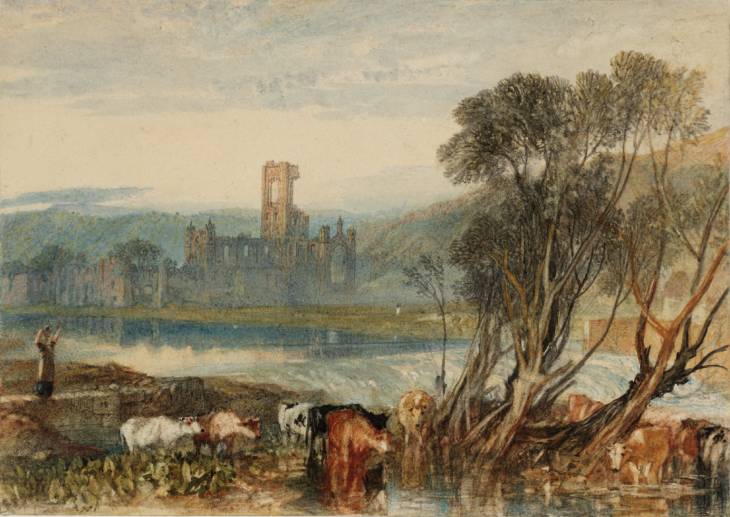Joseph Mallord William Turner Kirkstall Abbey, on the River Aire 1824
Joseph Mallord William Turner,
Kirkstall Abbey, on the River Aire
1824
Joseph Mallord William Turner 1775–1851
Kirkstall Abbey, on the River Aire 1824
D18146
Turner Bequest CCVIII M
Turner Bequest CCVIII M
Watercolour on paper on white wove watercolour paper, 160 x 225 mm
Watermark [J Wh]atman | [Turke]y Mills
Watermark [J Wh]atman | [Turke]y Mills
Accepted by the nation as part of the Turner Bequest 1856
Exhibition history
1904
National Gallery, London, various dates to at least 1904 (173).
1937
Display of Watercolours from the Turner Bequest, Tate Gallery, London, December 1937–September 1939, Tate Gallery, ?1945–December 1952 (no catalogue).
1965
[Display of Watercolours from the Turner Bequest], Tate Gallery, London, [?]–?March 1965 (no catalogue, Kirkstall Abbey, on the River Aire).
1974
Turner 1775–1851, Royal Academy, London, November 1974–March 1975 (239).
1975
Turner in the British Museum: Drawings and Watercolours, Department of Prints and Drawings, British Museum, London, May 1975–February 1976 (86).
1976
J.M.W. Turner 1775–1851: Akvareller og Tegninger fra British Museum, Statens Museum for Kunst, Copenhagen, February–May 1976 (24).
1976
William Turner und die Landschaft seiner Zeit, Hamburger Kunsthalle, May–July 1976 (48 reproduced as Die Abeti Kirkstall am Aire-Fluß).
1980
Turner in Yorkshire, York City Art Gallery, June–July 1980 (138).
1991
Turner: The Fourth Decade: Watercolours 1820–1830, Tate Gallery, London, January–May 1991 (15).
1993
J.M.W. Turner 1775–1851: Impressions de Gran Bretanya i el Continent Europeu / Impresiones de Gran Bretaña y el Continente Europeo, Centre Cultural de la Fundació ”la Caixa”, Barcelona, September–November 1993, Sala de Exposiciones de la Fundación ”la Caixa”, Madrid, November 1993–January 1994 (35, reproduced in colour).
1994
J.M.W. Turner 1775–1851: Aquarelles et Dessins du Legs Turner: Collection de la Tate Gallery, Londres/Watercolours and Drawings from the Turner Bequest: Collection from the Tate Gallery, London, Palais des Beaux-Arts de Charleroi, September–December 1994 (35, reproduced in colour).
2005
Turner’s Picture of Britain, Clore Gallery, Tate Britain, London, June 2005–April 2006 (no catalogue).
References
1904
E.T. Cook and Alexander Wedderburn (eds.), Library Edition: The Works of John Ruskin: Volume XIII: Turner: The Harbours of England; Catalogues and Notes, London 1904, p.615, no.173, as ‘The Aire. Kirkstall Abbey’.
1909
A.J. Finberg, A Complete Inventory of the Drawings of the Turner Bequest, London 1909, vol.II, p.630, CCVIII M, as ‘Kirkstall Abbey, on the River Aire’.
1990
Eric Shanes, Turner’s England 1810–38, London 1990, p.111, no.86 (colour).
1991
Ian Warrell, Turner: The Fourth Decade: Watercolours 1820–1830, exhibition catalogue, Tate Gallery, London 1991, p.33, no.15 reproduced.
2008
David Hill, Turner and Leeds: Image of Industry, Leeds 2008, pp.169–171, reproduced colour, 172–179, 180–1.
Art historian David Hill points out that both pictures of Kirkstall produced for the Rivers series ‘show a south-east view of the abbey...[Turner] consciously manipulate[ing] the angle to be the same in each composition’ to provide a sense of continuity and comparison.1 This view of the abbey, then, ‘records the traditional, Arcadian ideal, the kind of ideal (if never quite the reality) of the world into which he [Turner] was born’.2 In contrast, writes Hill, Turner’s view of Kirkstall Lock represents ‘the changing, fractious, accelerating...human world that he came to acknowledge and inhabit’.3
Though the sketches for this watercolour were made in in the winter, here Turner offers an image of late summer lushness. On the left a woman herds her cattle to drink from a pool of fresh water, rendered with enticing reflectivity. A morning mist hangs heavy around the abbey which is ‘everywhere...mantled with luxurious ivy, – that generous plant, which throws a veil over the deformities of ruin, and adds to the impression of its grandeur and beauty’.4
Thomas Girtin’s drawing of Kirkstall Abbey on the River Aire was also included with Turner’s two drawings of Kirkstall in the Rivers of England series (T04868). Girtin was a great friend of Turner and the two had trained together as young men. They were both early visitors to the Leeds area under the patronage of Edward Lascelles of Harewood House.5 There is a fine pencil study and a finished watercolour of the abbey by Girtin of 1797 (Tate D36589, D36639; Turner Bequest CCCLXXVII 18, CCCLXXIX 12).
For Turner’s sketches and studies of Kirkstall Abbey see the North of England sketchbook of 1797 (Tate D00916–D00922; Turner Bequest XXXIV 10a–16); the Tweed and Lakes sketchbook of the same date (Tate D01083, D01083; Turner Bequest XXXV 2, 81); the Kirkstall sketchbook of 1808 (Tate D07258–D07273, D07278; Turner Bequest CVII 2–16, 21); the Kirkstall Lock sketchbook of 1809 (Tate D12254–D12257, D12260; Turner Bequest CLV13–16, 19); and finally the Brighton and Arundel sketchbook of about 1824 (Tate D18390–D18391, D18393–D18399, D18409–D18416; Turner Bequest CCX 48–48a, 50–53, 58a–62).
This drawing was engraved in mezzotint by John Bromley and was published in 1826 (Tate impressions T04810, T04811, T06371).
This drawing was engraved in mezzotint by John Bromley and was published in 1826 (Tate impressions T04810, T04811, T06371).
Verso:
Stamped in black with Turner Bequest monogram and ‘CCVIII–M’ at centre; inscribed in pencil ‘34’ at centre towards right and ‘M’ at bottom towards right.
Alice Rylance-Watson
March 2013
How to cite
Alice Rylance-Watson, ‘Kirkstall Abbey, on the River Aire 1824 by Joseph Mallord William Turner’, catalogue entry, March 2013, in David Blayney Brown (ed.), J.M.W. Turner: Sketchbooks, Drawings and Watercolours, Tate Research Publication, August 2014, https://www

